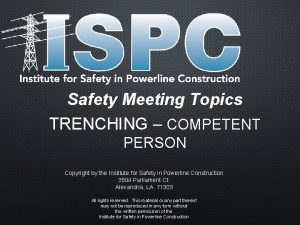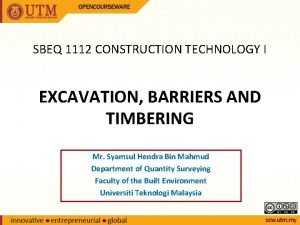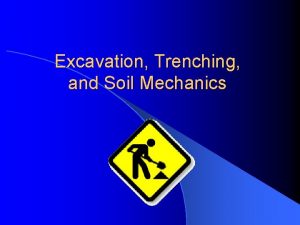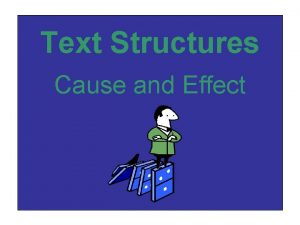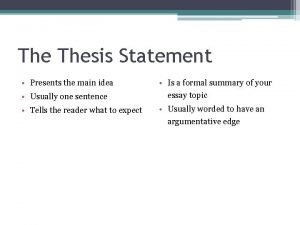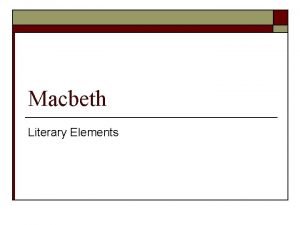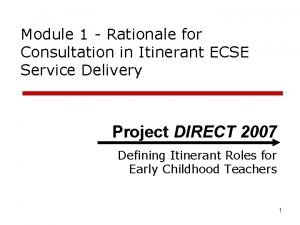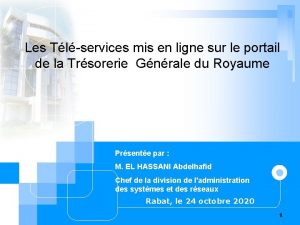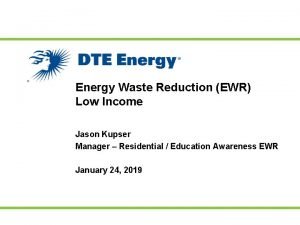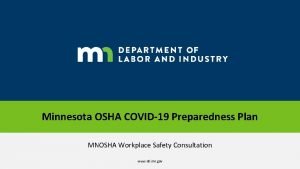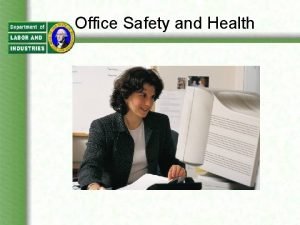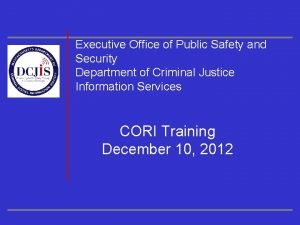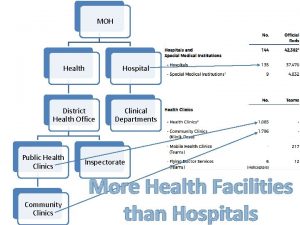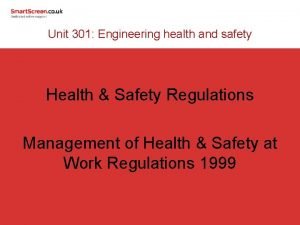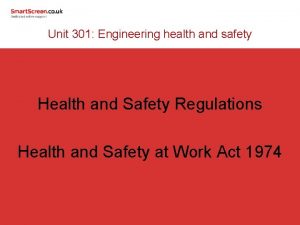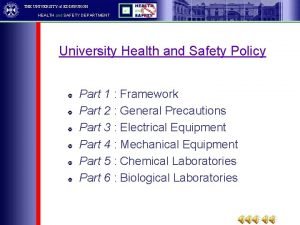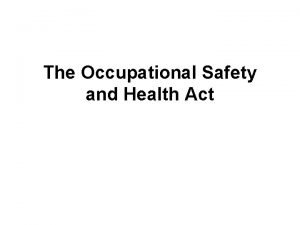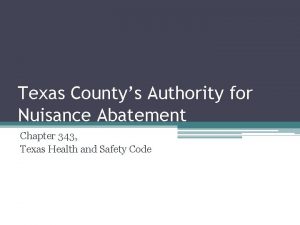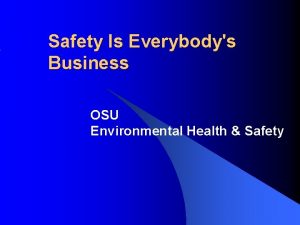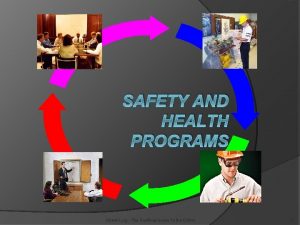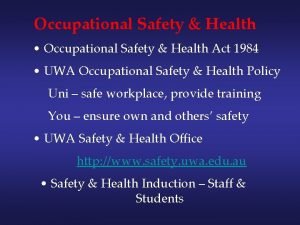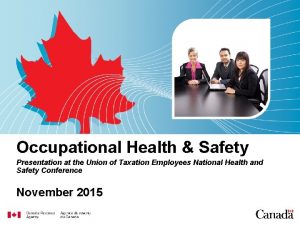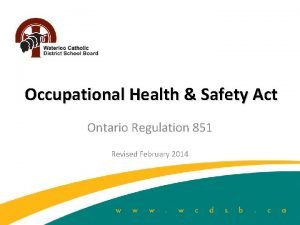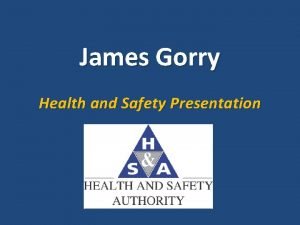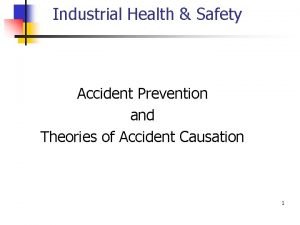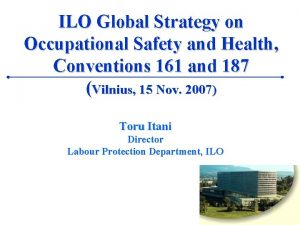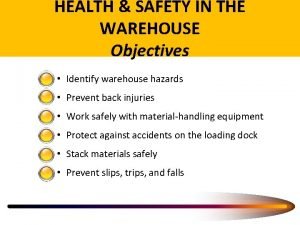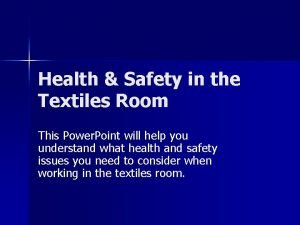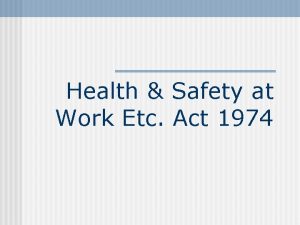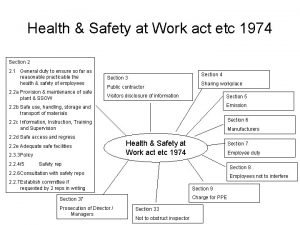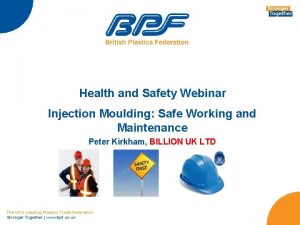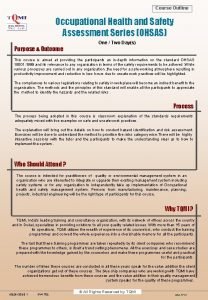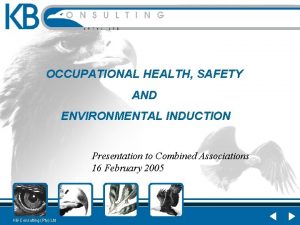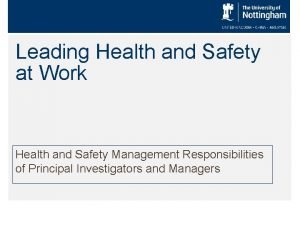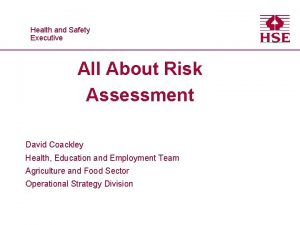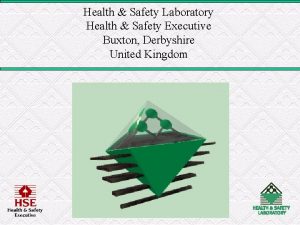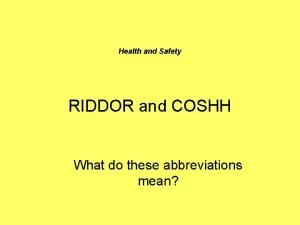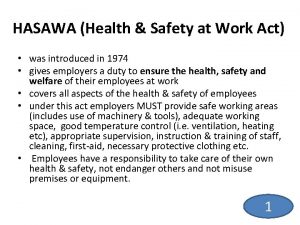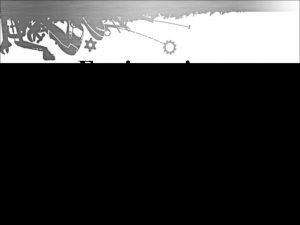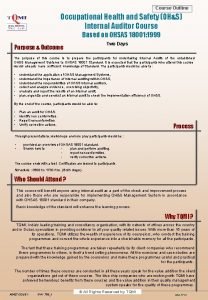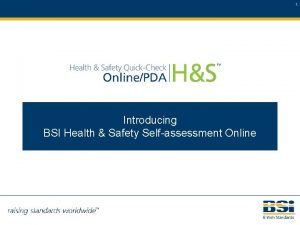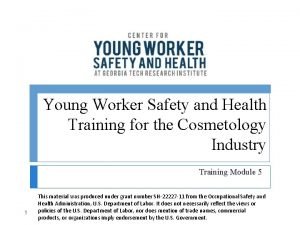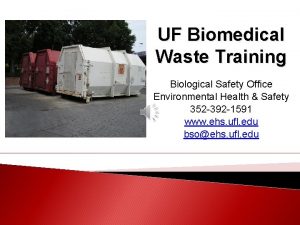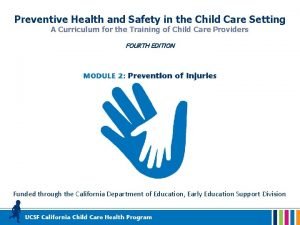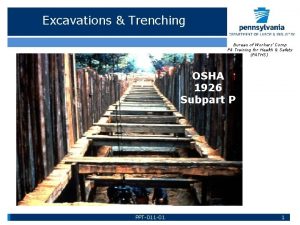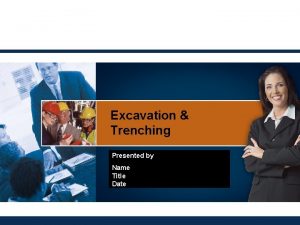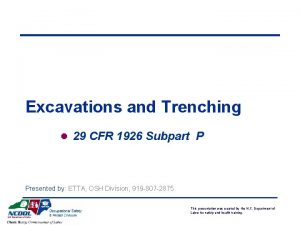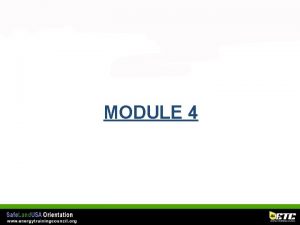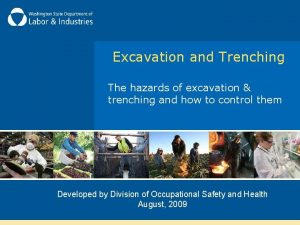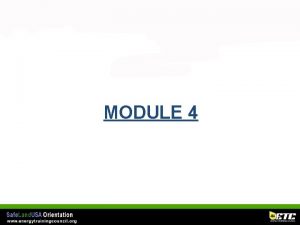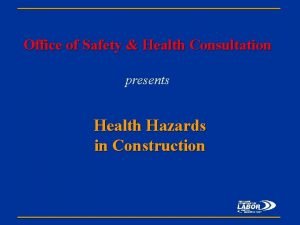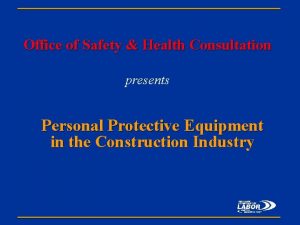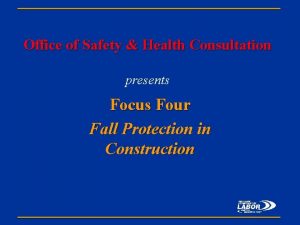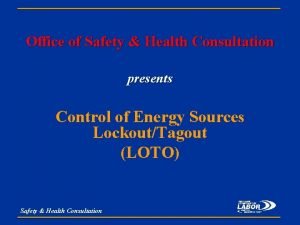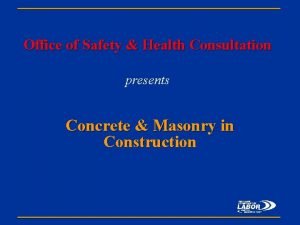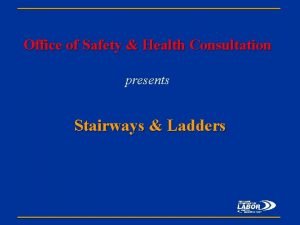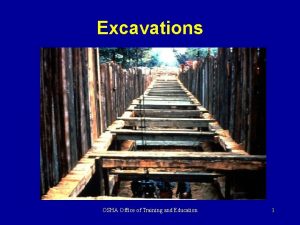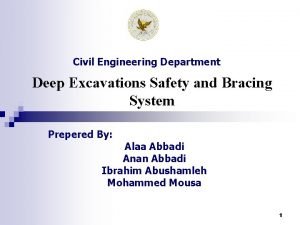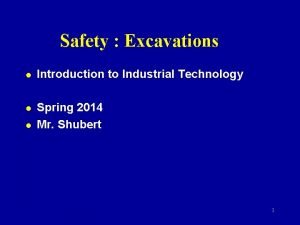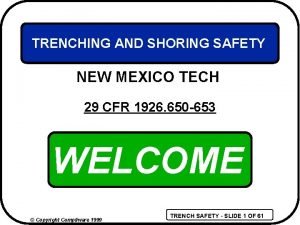Office of Safety Health Consultation presents Excavations Trenching













![Underground Installations • Estimated location of utility installations [sewer, telephone, fuel, electric, water lines] Underground Installations • Estimated location of utility installations [sewer, telephone, fuel, electric, water lines]](https://slidetodoc.com/presentation_image_h/f644331c793652503f93250eeab08872/image-14.jpg)









































































































- Slides: 119

Office of Safety & Health Consultation presents Excavations & Trenching

Objectives In this course, we will discuss the following: • Excavations/Trenching: Subpart P – 1926. 650 - Scope, application, and definitions applicable to this subpart – 1926. 651 - Specific excavation requirements – 1926. 652 - Requirements for protective systems 1926 Subpart P

Subpart and Standard 1926. Number of Serious Violations – FY 2013 Subpart P Excavations (1926. 650 - 652) 3

Subpart P - Appendices • Appendix A - Soil Classification • Appendix B - Sloping and Benching • Appendix C - Timber Shoring for Trenches • Appendix D - Aluminum Hydraulic Shoring • Appendix E - Alternatives to Timber Shoring • Appendix F - Selection of Protective Systems 1926 Subpart P

Definitions • Excavation – Man-made cut, cavity, trench, or depression formed by earth removal. • Trench – Narrow excavation – Depth is greater than the width, but not wider than 15 feet. • Shield – Structure able to withstand a cave-in and protect employees. 1926. 650(b)

Definitions • Shoring – Structure that supports the sides of an excavation and protects against cave-ins. • Sloping – Technique that employs a specific angle of incline on the sides of the excavation. 1926. 650(b)

Definitions • Competent person – Must have specific training in and be knowledgeable about: • Soils classification • Use of protective systems • Requirements of the standard – Must be capable of identifying hazards, and authorized to eliminate them. 1926. 650(b)

Weight of Soil • Weight of soil varies with type and moisture content. • One cubic foot weighs 110 pounds to 140 pounds. • One cubic yard (27 cubic feet) of soil can weigh more than 3, 000 pounds.

Excavation Hazards • Cave-ins are the greatest risk. • Other hazards include: – Asphyxiation due to lack of oxygen – Inhalation of toxic materials/fumes – Fire – Machinery moving near edge of excavation causing a collapse – Severing underground utility lines – Falls

Injury and Death • Excavating is one of the most hazardous construction operations. • Most accidents occur in trenches 5 -15 feet deep. • Usually no warning before a cave-in.

Specific Excavation Requirements • • (a) Surface encumbrances (b) Underground installations (c) Access and egress (d) Exposure to vehicular traffic (e) Exposure to falling loads (f) Warning system for mobile equipment (g) Hazardous atmospheres

Specific Excavation Requirements • (h) Protection from hazards associated with water accumulation • (i) Stability of adjacent structures • (j) Protection of employees from loose rock or soil • (k) Inspections • (l) Fall protection

Surface Encumbrances • All surface encumbrances that create a hazard to employees must be removed or supported to safeguard employees. 1926. 651(a)
![Underground Installations Estimated location of utility installations sewer telephone fuel electric water lines Underground Installations • Estimated location of utility installations [sewer, telephone, fuel, electric, water lines]](https://slidetodoc.com/presentation_image_h/f644331c793652503f93250eeab08872/image-14.jpg)
Underground Installations • Estimated location of utility installations [sewer, telephone, fuel, electric, water lines] must be determined prior to opening an excavation. 1926. 651(b)(1)

Underground Installations • When utility companies or owners cannot respond to request to locate underground utility installations within 24 hours. – Employer may proceed with caution, provided detection equipment, etc. is used to locate utility installations. 1926. 651(b)(2)

Underground Installations • Exact location of underground installations must be determined by safe and acceptable means. 1926. 651(b)(3)

Underground Installations 1926. 651(b)(3)

Underground Installations 1926. 651(b)(3)

Underground Installations • Underground installations must be protected, supported or removed as necessary to safeguard employees. 1926. 651(b)(4)

Structural Ramps • Structural ramps used for access or egress of equipment must be designed by a competent person. 1926. 651(c)(1)(i)

Egress - Trench Excavation • Stairway, ladder, ramp, or other safe means of egress must be located in trench. • Required if trench 4 feet or more in depth. • Lateral travel distance no more than 25 feet. 1926. 651(c)(2)

Egress - Trench Excavation 25 feet Ramp, ladder or stairs required at 4 feet or deeper. 1926. 651(c)(2)

Egress - Trench Excavation 1926. 651(c)(2)

1926. 651(c)(2) Egress - Trench Excavation • Is this correct?

Exposure to Vehicle Traffic • Employees exposed to public vehicular traffic must wear warning vests or other suitable garments marked with or made or reflectorized or high-visibility material. 1926. 651(d)

Exposure to Falling Loads • Employees must not be permitted to work under loads handled by lifting or digging equipment. 1926. 651(e)

Exposure to Falling Loads • Stand away from equipment that is being loaded or unloaded. • Equipment operators may stay in their equipment during loading and unloading if equipment has proper cab shield or canopy. 1926. 651(e)

Warning System - Mobile Equipment • Mobile equipment operated adjacent to excavation and operator cannot see edge of the excavation: – Warning system must be utilized. • Barricades • Hand or mechanical signals • Stop logs 1926. 651(f)

Warning System - Mobile Equipment Is this correct? 1926. 651(f)

Hazardous Atmospheres • Testing conducted before employees enter the trench and regularly thereafter. 1926. 651(g)(1)

Hazardous Atmospheres • Less than 19. 5% or more than 23. 5% oxygen • A combustible gas concentration greater than 20% of the Lower Flammable Limit (LFL) • Concentrations of hazardous substances that exceed OSHA’s Permissible Exposure Limits (PEL) 1926. 651(g)(1)

Hazardous Atmospheres • Test at 4 feet if suspected – LEL – Oxygen – CO – H 2 S – Petroleum – Other toxics 1926. 651(g)(1)

Emergency Rescue Equipment 1926. 651(g)(2)(i)

Emergency Rescue Equipment • Emergency rescue equipment must be readily available where hazardous atmospheric conditions exist or expected to develop during work. – Breathing apparatus – Safety harness and line – Basket stretcher 1926. 651(g)(2)(i)

Water Accumulation • Employees must not work in excavations where there is accumulated water, or where water is accumulating. • Unless precautions taken to protect workers: – Water removal to control level of water – Special support or shield systems 1926. 651(h)(1)

Water Accumulation 1926. 651(h)(1)

Water Accumulation • Water removal equipment and operations must be monitored by a competent person to ensure properation. 1926. 651(h)(2)

Water Accumulation • Excavations subject to runoff from heavy rains require an inspection by a competent person. 1926. 651(h)(3)

Well Points Used to Remove Ground Water

What are the Hazards?

What are the hazards?

Stability of Adjacent Buildings • Support systems such as shoring, bracing, or underpinning must be provided to ensure stability of structures. 1926. 651(i)(1)

Stability of Adjacent Structures • Excavation below the foundation that could pose a hazard shall not be permitted except: • ‘ – Underpinning provided – Stable rock – Registered professional engineer (RPE) has approved 1926. 651(i)(2)

Underpinning to prevent structural failure. 1926. 651(i)(2)(i)

Stability of Adjacent Structures • Sidewalks, pavements and appurtenant structure must not be undermined unless supported to protect employees from collapse of such structures. 1926. 651(i)(3)

Protection of Employees • Adequate protection provided to protect employees from loose rock or soil that could pose a hazard by falling or rolling from an excavation face. 1926. 651(j)(1)

Potential Problems Extra load from spoil pile Fissures Belly bulge

Protection of Employees • Employees must be protected from equipment or materials that could fall or roll into excavations. – Materials and equipment must be kept 2 feet from edge of excavation or use retaining devices. 1926. 651(j)(2)

Rule: 2 Feet 1926. 651(j)(2)

Two Feet From Edge 1926. 651(j)(2)

Extra Surface Loading

1. What’s the Hazard?

2. See it now…

Inspections – Competent Person • Daily and before the start of each shift. • As dictated by the work being done in the trench. • After every rain storm and other events that could increase hazards, e. g. , snowstorm, windstorm, thaw, earthquake, etc. 1926. 651(k)(1)

Inspections • Frequency of testing should be increased if equipment is operating in trench as well as if welding, cutting, or burning is done in trench. 1926. 651(k)(1)

Fall Protection • Walkways provided when crossing over excavation. • Standard guardrail installed when more than 6 feet above a lower level. 1926. 651(l)(1)

Protection of Employees • Employees in an excavation must be protected from cave-ins by adequate protective system. – Except when: • Made entirely in stable rock • Excavation is less than 5 feet deep and examined by competent person 1926. 652(a)(1)

Sliding

Toppling

Tension Crack

Bulging

Heaving or Squeezing Soil Weight

Methods of Protection • Sloping and benching • Shoring (spaced sheeting, closed sheeting) • Trench shield • Other occasionally used systems 1926. 652

Protective Systems • Protective systems shall have capacity to resist without failure all loads applied or transmitted to the system. 1926. 652(a)(2)

Installation and Removal • Support systems must be installed and removed in a manner that protects employees from cave-ins. 1926. 652(e)(1)(ii)

Installation and Removal • Removal must begin at, and progress from, the bottom of the excavation. • Members released slowly to note any indication of possible failure of remaining members. 1926. 652(e)(1)(V)

Installation and Removal • Excavations of material to a level not greater than 2 feet below the bottom of the support system or shield must not be permitted. 1926. 652(e)(2)(i) and (g)(2)

Deadly Trench Collapse


What’s the hazard?

What’s the hazard?

What’s the hazard?

What’s the hazard?

What’s the hazard?

What’s the hazard?

What’s the hazard?

Soil Classification • Contains definitions • Sets forth requirements • Describes acceptable visual and manual test for use in classifying soils Appendix A

Definitions • Cohesive soil – Clay, or soil with a high clay content, which has cohesive strength – Does not crumble – Can be excavated with vertical side slopes – Plastic when moist – Hard to break up when dry Soil types Appendix A

Definitions • Granular soil – Gravel, sand, or silt, with little or no clay content – No cohesive strength – Cannot be molded when moist – Crumbles easily when dry Note: Some moist granular soils exhibit apparent cohesion Appendix A

Definitions • Unconfined compressive strength – Load per unit area at which a soil will fail in compression Note: Estimated in the field by use of a pocket penetrometer, thumb penetration test, and other methods Appendix A

Thread Test • Roll into thread • At least 2 inches in length • Longer unbroken thread means more cohesive Appendix A

Ribbon Test • Roll soil into a cigar shape • Pinch between thumb and finger • Longer ribbon means more cohesive Appendix A

Thumb Penetration Test Appendix A

Pocket Penetrometer Appendix A

Type A Soil • Most stable: clay, silty clay, and hardpan • Not fissured • Not subjected to vibration of any type • Never been previously disturbed • No seeping water Unconfined compressive strength greater than 1. 5 tons per square foot (tsf) Appendix A

Type B Soil • Medium stability: silt, sandy loam, medium clay and unstable dry rock • Previously disturbed soils unless otherwise classified as type C • Soils that meet the requirements of Type A but are fissured or subject to vibration Unconfined compressive strength less than 1. 5 tsf and greater than 0. 5 tsf Appendix A

Type C Soil • Least stable: gravel, loamy sand, soft clay • Submerged soil or dense, heavy unstable rock • Soil from which water is freely seeping Unconfined compressive strength 0. 5 tsf or less Appendix A

Sloping and Benching • Contains definitions • Sets forth requirements • Configurations of sloping and benching Appendix B

Allowable Slopes Soil Type Height/Depth Ratio Slope Angle Stable rock Vertical 90° Type A ¾: 1 53° Type B 1: 1 45° Type C 1½: 1 34° Type A (short term) ½: 1 63° (For a maximum excavation depth of 12 ft) Table B-1

Excavations Made in Type “A” Soil Simple Slope

Excavations Made in Type “A” Soil Simple Slope – Short Term

Excavations Made in Type “A” Soil Simple Bench

Excavations Made in Type “A” Soil Unsupported Vertically-Sided Lower Portion

Excavations Made in Type “A” Soil Unsupported Vertically-Sided Lower Portion

Excavations Made in Type “A” Soil Multiple Bench

Excavations Made in Type “A” Soil Support or Shield System

Excavations Made in Type “B” Soil Simple Slope

Excavations Made in Type “B” Soil Single Bench

Excavations Made in Type “B” Soil Multiple Bench

Excavations Made in Type “B” Soil Support or Shield System

Excavations Made in Type “C” Soil Simple Slope

Excavations Made in Type “C” Soil Support or Shield System

Excavations Made in Layered Soils A over B

Excavations Made in Layered Soils A over C

Excavations Made in Layered Soils B over A

Excavations Made in Layered Soils B over C

Excavations Made in Layered Soils C over A

Excavations Made in Layered Soils C over B

Benching and Sloping

Timber Shoring for Trenches • Need to determine soil classification • Presentation of information • Basis and limitations of the data • Use of tables • Examples to illustrate the use of tables • Notes for all tables Appendix C

Aluminum Hydraulic Shoring • Need to determine soil classification • Presentation of information • Basis and limitations of the data • Use of tables • Example to illustrate the use of the tables • Footnotes, and general notes Appendix D

Figure No. 1 Vertical Aluminum Hydraulic Shoring (Spot Bracing) ng i c al t n o z i a p S r o H 18” Max. . Vertical Rail Vertical Spacing 4’ Max. Hydraulic Cylinder 2’ Max.

Figure No. 2 Vertical Aluminum Hydraulic Shoring (With Plywood) Horizontal Spacing Vertical Rail Hydraulic Cylinder 18” Max. Vertical Spacing Plywood 4’ Max. 2’ Max.

Figure No. 3 Vertical Aluminum Hydraulic Shoring (Stacked) Horizontal Spacing Hydraulic Cylinder Vertical Spacing 4’ Max. Vertical Rail 2’ Max.

Figure No. 4 Aluminum Hydraulic Shoring Waler System (Typical) Horizontal Spacing Upright Sheeting Waler 2’ Max. Vertical Spacing 4’ Max. Hydraulic Cylinder

Alternatives to Timber Shoring Appendix E

Alternatives to Timber Shoring Appendix E

Selection of Protective Systems • Illustrates a graphic summary of requirements contained in subpart P for excavations 20 feet or less in depth. • Protective systems for use in excavations more than 20 feet in depth must be designed by a registered professional engineer in accordance with 1926. 652(b) and (c). Appendix F

Your Questions?
 Trenching and excavation safety meeting
Trenching and excavation safety meeting Continuous tubular rails
Continuous tubular rails Surface encumbrances osha
Surface encumbrances osha Cause and effect signal words
Cause and effect signal words Presents from my aunts in pakistan poem
Presents from my aunts in pakistan poem Presents from my aunts in pakistan poem analysis
Presents from my aunts in pakistan poem analysis Business agility metrics
Business agility metrics 16 3 darwin presents his case answer key
16 3 darwin presents his case answer key Section 15-3 darwin presents his case answers
Section 15-3 darwin presents his case answers Zids and zods
Zids and zods Sue palmer skeleton books
Sue palmer skeleton books Zids and zods answers
Zids and zods answers Prose writing that presents and explains ideas
Prose writing that presents and explains ideas Prose writing that presents and explains ideas
Prose writing that presents and explains ideas Gurmit paid £21 for five presents
Gurmit paid £21 for five presents Nollaig shona meaning
Nollaig shona meaning Pour cet immense bonheur alléluia
Pour cet immense bonheur alléluia Is thesis statement and main idea the same
Is thesis statement and main idea the same A 26 year old female presents
A 26 year old female presents This presents
This presents A dramatic work that presents the downfall of a character
A dramatic work that presents the downfall of a character Name and define the four narrative essentials of a play
Name and define the four narrative essentials of a play Sue palmer discussion book
Sue palmer discussion book Shcedules
Shcedules Tragedy
Tragedy What type of communication is shown in this poster
What type of communication is shown in this poster A thesis statement presents
A thesis statement presents Which sentence presents a faulty either/or argument?
Which sentence presents a faulty either/or argument? Chapter 17 neurologic emergencies
Chapter 17 neurologic emergencies Client centered case consultation
Client centered case consultation Pwsb belgium
Pwsb belgium Triadic consultation
Triadic consultation Tgr portail
Tgr portail Dteenergy.com/hec
Dteenergy.com/hec Consultation skills for pharmacy practice
Consultation skills for pharmacy practice Neighbor consultation model
Neighbor consultation model Helman consultation model
Helman consultation model Triadic-dependent
Triadic-dependent Balint model of consultation
Balint model of consultation Www.consultationskillsforpharmacy.com
Www.consultationskillsforpharmacy.com Bradford vts consultation models
Bradford vts consultation models Deer oaks consultation services
Deer oaks consultation services Behavioral consultation
Behavioral consultation What are the golden rules of human relations?
What are the golden rules of human relations? Wooden pusher definition cosmetology
Wooden pusher definition cosmetology Home buyer consultation
Home buyer consultation Wedding consultation form
Wedding consultation form Consultation skills for pharmacy practice
Consultation skills for pharmacy practice Balint consultation model
Balint consultation model Service delivery consultation
Service delivery consultation Consultation collocation
Consultation collocation Dr hamza andreea
Dr hamza andreea Sdcc consultation portal
Sdcc consultation portal Pa osha consultation
Pa osha consultation Minnesota osha
Minnesota osha Pendleton consultation model
Pendleton consultation model Microslide consultation
Microslide consultation Office and factory
Office and factory Common office hazards
Common office hazards Oxford university safety office
Oxford university safety office Electrical safety office ghaziabad
Electrical safety office ghaziabad Executive office of public safety and security
Executive office of public safety and security Where do you activate the four shades function
Where do you activate the four shades function Qbs safety care
Qbs safety care Process safety vs personal safety
Process safety vs personal safety Safety assessment for ind safety reporting
Safety assessment for ind safety reporting Basic safety orientation
Basic safety orientation Basic safety orientation
Basic safety orientation Office of health standards compliance
Office of health standards compliance Municipal health board
Municipal health board Office of minority health resource center
Office of minority health resource center Va office of health informatics
Va office of health informatics Morris county office of health management
Morris county office of health management Drtamil.me
Drtamil.me Four cs health and safety
Four cs health and safety Health and safety at work act engineering
Health and safety at work act engineering Health and safety edinburgh
Health and safety edinburgh Objective of occupational health
Objective of occupational health Care certificate standard 14 answers
Care certificate standard 14 answers Texas health and safety code 343
Texas health and safety code 343 Six pack health and safety regulations
Six pack health and safety regulations Kpi health and safety
Kpi health and safety Osu environmental health and safety
Osu environmental health and safety Oshax
Oshax Benefits of a safety and health program
Benefits of a safety and health program Health and safety in hrm
Health and safety in hrm Occupational health and safety act 1984
Occupational health and safety act 1984 Occupational health and safety presentation
Occupational health and safety presentation Regulation 851
Regulation 851 James gorry health and safety
James gorry health and safety Ipac course online
Ipac course online Human factor theory
Human factor theory Global strategy on occupational safety and health
Global strategy on occupational safety and health Warehouse health and safety requirements
Warehouse health and safety requirements Safety in the textiles room
Safety in the textiles room Health and safety at work act 1974 section 3
Health and safety at work act 1974 section 3 Health and safety at work act
Health and safety at work act Health and safety on computers
Health and safety on computers Health and safety precautions when using ict
Health and safety precautions when using ict Guarding suppliers for injection moulding
Guarding suppliers for injection moulding Occupational health and safety course outline
Occupational health and safety course outline Traffic light safety plan mental health
Traffic light safety plan mental health Textiles health and safety
Textiles health and safety Food safety management system template
Food safety management system template Environmental induction training ppt
Environmental induction training ppt Leading health and safety at work
Leading health and safety at work Health and safety risk assessment template
Health and safety risk assessment template Health and safety buxton
Health and safety buxton What does riddor stand for?
What does riddor stand for? Health and safety in performing arts
Health and safety in performing arts Health and safety in performing arts
Health and safety in performing arts What is the purpose of hasawa
What is the purpose of hasawa Esh environmental safety health
Esh environmental safety health 6 pack regulations
6 pack regulations Occupational health and safety course outline
Occupational health and safety course outline Safety health and environment apprenticeship
Safety health and environment apprenticeship Bsi online
Bsi online Safety and health policy example
Safety and health policy example Eh&s uf
Eh&s uf Preventive health and safety in the child care setting
Preventive health and safety in the child care setting
